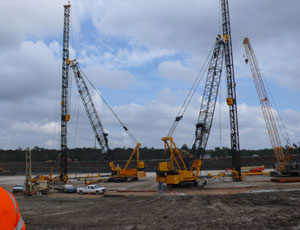Another behemoth civil works project is taking shape in New Orleans as construction of the $1 billion Gulf Intracoastal Waterway (GIWW) West Closure Complex project rapidly advances.
Since receiving the notice to proceed August 4, Gulf Intracoastal Constructors, a joint venture of Omaha-based Kiewit Corp. and Traylor Bros. Inc. of Evansville, Ind., has been working round-the-clock. GIC has already cleared and grubbed most of the 200-acre site, built 4,000 ft of roadway, and excavated 150,000 cu yd of dirt.

The U. S. Army Corps of Engineers surge barrier/pump station combination is designed to reduce flooding from hurricane and storm surge for communities on the west bank of the Mississippi River in the New Orleans area. In that respect, it mirrors the Corps’ $1.3-billion Inner Harbor Navigation Canal Lake Borgne storm surge barrier being constructed by local contractor Shaw Environmental on the eastern side of New Orleans.
The IHNC barrier is being constructed on the water, but the GIWW West Closure Complex site straddles both marshy, soft -soil land and water. The complex will feature two navigation gates, concrete floodwalls, earthen levee and a 20,000-cfs pump station, the largest in the country.
“We’ve already started driving the 137-ft-long, 30-inch steel pipe piles for the pump station foundation,” says Kevin Wagner, Corps project manager. Currently, 871 of the requisite 1,375 piles are on site. GIC is using two, 2250/300 ton Manitowoc cranes with 180-ft-long leads to drive the piles to �162 ft. The pump station foundation will be at -25 ft.
GIC has also set up field offices, a concrete batch plant and pug mill. “The pug mill is producing cement treated sand to line the base of the pit for the pump station so we could move equipment in,” Wagner says. The footprint for the station will be 141 ft by 642 ft and will eventually be at -26 ft. elevation. By October 30, the contractor had already excavated to -18 ft.
Some of the excavated material may be suitable to construct the approximately one-mile long earthen levee that is part of the project, Wagner says. However, the estimated 1 million cu yd of clay required is available in identified borrow pits on the site.
The GIWW West Closure complex will require approximately 180,000 cu yd of concrete. GIC’s batch plant will produce a daily average of approximately 1,500 cu yd and will surge to 1,800 cu yd per day.
“On October 26 the contractor started driving 54-inch-dia pipe piles to construct a coffer dam where the barge navigation opening will be,” Wagner says. The type of gate to be installed and the exact dimensions have not yet been determined. Analysis to inform the design is still ongoing at the Corps’ Engineering Research and Design Center in Vicksburg, Miss.
The project was the New Orleans District’s first Early Contractor Involvement contract, the Corps name for Construction Management at Risk. “By using ECI for this key project, our design teams and GIC are able to proceed in construction of some features, while actively participating in and providing pre-construction design services of other features,” says Colonel Alvin Lee, the Corps New Orleans District commander.
The GIWW complex demonstrates the teamwork between the Corps and local, state and federal authorities, says Major General Merdith “Bo” Temple, Corps deputy commanding general for civil and emergency operations. The use of ECI also demonstrates the “parallel” thinking, planning and activity required to deliver such a huge program by 2011, he adds.
In April, GIC was awarded the $6.97-million base portion of the ECI contract for pre-construction services and pile load tests. That allowed the contractor to begin design and construction sequencing even before being awarded the $854.8 million construction portion of the contract June 26 and the pump portion May 28.
The Corps is using design-build and ECI on many projects to speed up delivery of the Hurricane and Storm Damage Risk Reduction System. The uncertainty about specifics of the final project when using design build or ECI causes some concern for local stakeholders says Susan Maclay, president of the Southeast Louisiana Flood Protection Authority West. Still, having protection in place by June 1, 2011, is a welcome trade-off. “We applaud the Corps for thinking �outside of the box’ to allow the contractor to use ECI, to design while delivering,” Maclay says.
Scott Cassels, executive vice president and division manager for Kiewit, lead in the joint venture, says he’s excited about putting 1,000 people to work, especially in the current economic climate. “That’s as good as it gets for a contractor,” he says. GIC is committed to a safe environment on the project, Cassels adds. “We’re committed to open door communication where these craftsmen are valued and can participate in the process because we have zero chance to succeed unless the men and women who are going to build this work for us are trained and part of this team. They are critical to our success.”


